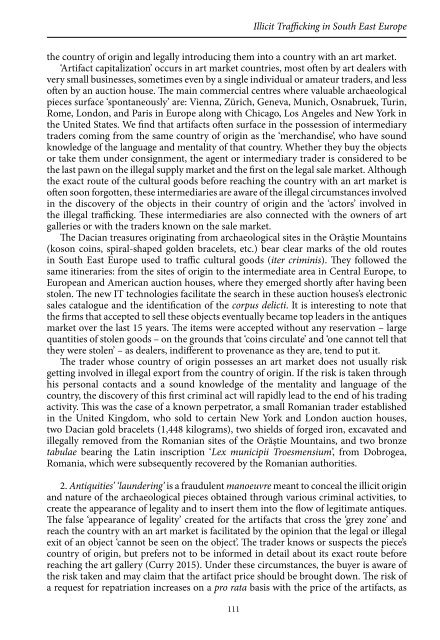Countering
Book_observatory_illicit_traffic_version%20issuu
Book_observatory_illicit_traffic_version%20issuu
You also want an ePaper? Increase the reach of your titles
YUMPU automatically turns print PDFs into web optimized ePapers that Google loves.
Augustin Lazăr<br />
it includes its artistic quality, rare nature and cultural importance. To mitigate this risk,<br />
the traders’ modus operandi consisted of several technical sale procedures such as taking<br />
the cultural good for sale under consignment subject to the payment of a commission<br />
representing a percentage from the sale price or lending the good to a museum in order<br />
to be exhibited for a period of time. The object is then considered as ‘laundered’, for the<br />
reason that no claims were raised during its public exhibition time (Deppert-Lippitz: 12).<br />
In our analysis of the issue related to antique laundering that purposes to create an<br />
appearance of legality, we find similarities with the judicial practice in the field of fighting<br />
money laundering. Thus, the specialized literature in the field of money laundering<br />
revealed that any crime-related activity may be described by means of three specific<br />
elements (Lazăr 2004: 21):<br />
• iter criminis. The itinerary followed by the perpetrator from the criminal<br />
resolution to the stage related to preparation acts, the execution stage,<br />
completed through the perpetration of a crime;<br />
• modus operandi. The operation method involving a set of activities, habits<br />
and procedures used, which characterize a criminal’s activity before, during<br />
and after the perpetration of a crime;<br />
• punctum saliens. The characteristic point, and details of the perpetration that<br />
may be noted through the observation of the criminal itinerary.<br />
With respect to the traffic in antiquities, these elements may appear upon careful<br />
examination of the circuit of acts, merchandise and payment methods, of the sequence<br />
and logic of the operations performed by traffickers, of the authenticity of documents,<br />
securities, etc.<br />
The judicial experience with regard to combating money laundering and the ability<br />
to identify the nature of dirty money calls for an adaptation of the Latin proverb ‘Pecunia<br />
non olet’ (Money does not smell) , with the phrase ‘Pecunia olet’ (Money does smell).<br />
It leaves verifiable tracks. Similarly, stolen cultural goods are traceable, starting with<br />
archaeological diggings Internet messages and images of the respective goods being<br />
offered for sale, the detectors and documents that indicate the poachers’ concerns, other<br />
treasure pieces left behind (or, ‘orphans’), the amounts transferred into the accounts of<br />
the individuals involved in the traffic, the procurement of valuable goods (luxury motor<br />
vehicles, houses, detection equipment, etc. A modus operandi similar to that used by the<br />
launderers of dirty money was the purchase by traffickers of a ‘car wash’ that allows them<br />
to maintain an appearance of legality after illegally capitalizing on the trafficked objects.<br />
3. The development of e-trade provided an evolved modus operandi to the networks<br />
of traffickers, which trade in cultural goods without a known legal origin. Internet sites<br />
allow them to perform operations without giving any details to their customers on the<br />
origin of the traded goods, with a very low degree of control by site administrators, thus<br />
ensuring an increased chance of preserving their anonymity.<br />
Web investigations highlighted the fact that a large number of heritage goods is sold on<br />
eBay, e.g. genuine art objects, archaeological artifacts and their reproductions. The most<br />
frequent sale method is the auction, whereby the seller can conceal the eBay identity of<br />
the auctioneer who, under the circumstances, does not know who their trading partners<br />
are. Another common sale method is when the seller sets a fixed price for an artifact, a<br />
method known on eBay as ‘buy it now for this price’/‘buy it now’. Payments are made<br />
112


